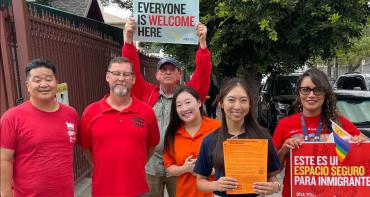Back-to-school time means first-day jitters and carefully chosen outfits, the smell of newly sharpened pencils, deciphering new class schedules and reuniting with friends you’ve missed all summer—but this year, it also means fear among educators and families who live in immigrant communities. As President Trump’s administration continues to terrorize school neighborhoods with Immigration and Customs Enforcement raids, teachers are doing everything they can to be sure students feel welcome and safe at school.
In Los Angeles, that means members of United Teachers Los Angeles rallied on the first day of school with signs that read, “Este es un espacio seguro para inmigrantes” (“This is a safe space for immigrants”) and “Todos son bienvenidos aquí” (“All are welcome here”). Festive signs greeted students outside schools, and teachers took to social media to let everyone know that they would protect their students.
With the memory of brutal ICE crackdowns and national guard deployment in June, the LA school district has set up safe zones to encourage families to send their children to school, even if they are afraid to go outside their houses. Adult volunteers escort “walking school buses” of children through their neighborhoods. And more than 1,000 teachers and community volunteers have been trained to patrol near the schools every morning and afternoon, reporting any ICE activity so that families can stay safe.
“Regardless of people’s politics, as educators we should all unite around the idea that every child, no matter where they’re from or what their status is, deserves to feel safe and deserves an education,” says Ron Gochez, a history teacher and member of UTLA who has been active patrolling school areas. “That’s what we’re trying to ensure.”
Why it matters
There are about 47.8 million immigrants living in the United States, and more than 17 million children with at least one immigrant parent. About 11.5 million people in the United States are undocumented immigrants. But it’s not just undocumented people who are being targeted: In some cases, U.S. citizens and other lawful permanent residents are being racially profiled and arrested in the street.
Families who are of mixed status—with some members in the United States legally and others undocumented—are especially vulnerable. And non-immigrant children whose classmates all of a sudden disappear, whether it is because their parents are afraid to send them to school or because they’ve been deported, are anxious and fearful about what is happening around them.
“Students are already wondering if armed agents will be waiting for them or their classmates,” said Cecily Myart-Cruz, president of United Teachers Los Angeles, one week into the school year. “The trauma and the heartbreak are palpable.”
Myart-Cruz was speaking at a press conference Aug. 20 to talk about the arrest of Benjamin Marcelo Guerrero Cruz, who was snatched while walking his dog just a week before starting his senior year of high school. According to one of his teachers, a group of men, some masked, grabbed Benjamin by the arm and asked if he was another person, and when he answered he was not, they arrested him anyway. He overheard them bragging about the money they would get for arresting him—as if they were bounty hunters—before they turned him over to ICE officers. He was eventually taken to a crowded cell, and at press time he remained in custody. UTLA has joined Unión del Barrio, a local advocacy group, and others to demand Benjamin’s release.
“Benjamin is somebody’s baby. He is one of our students,” said Myart-Cruz. “His empty desk is another painful reminder of how cruel the immigration system has become.” And it isn’t just Benjamin who is at risk here, she said. “It could happen to my son. It could happen to your son. It could happen to your neighbor, it could happen to your students. Even if you are not in danger of this happening, it affects all of us.”
Not the only one
These sorts of abductions have happened in other places as well. A Cincinnati student was arrested while trying to keep a court appointment to renew his status. A teenager in Milford, Mass., was detained on his way to volleyball practice. Another, in Detroit, was arrested on his way to a school field trip.
At one of the AFT’s Know Your Rights sessions with the Orange County Classroom Teachers Association in Florida, parents recounted how they were sending their kids to school with a note of an emergency contact in their backpacks just in case a parent is deported and no one is able to pick up their kids at school—an all-too-common occurrence across the country. Parents are fearful of doing anything “extra,” says Alfonso Treto, who teaches in the Migrant Education Program in Miami-Dade County, Fla., and is a member of United Teachers of Dade. And by “extra,” he means things like going to the park. Many have other people do their shopping for them, because they are afraid to go to the grocery store.
“Parents are self-deporting,” says Treto. Some families left earlier this year when Florida passed a series of anti-immigrant laws criminalizing the transportation of undocumented people into Florida, requiring hospitals to report patient immigration status and restricting access to driver’s licenses for undocumented people. “They transitioned to other states or even went back to their home countries,” he says.
What we are doing
School districts and union affiliates are doing what they can to mitigate the harm. In Washington, D.C., the Washington Teachers’ Union has held online sessions for parents and teachers offering strategies to keep families safe, including Know Your Rights information. The Boston Teachers Union has launched an Everyone Is Welcome Here campaign with resources and connections to legal support. The Chicago Teachers Union holds Know Your Rights workshops, bargained sanctuary measures into its contract and established protocols regarding ICE visits to schools. And in New York City, the United Federation of Teachers has held trainings, urging educators to practice verbal responses to ICE demands; provided localized online resources to members; and partnered with other community organizations.
The AFT maintains a bank of resources for members and others who need them, with an educator’s guide to support immigrant youth and families; it’s also available in Spanish. The resources also include Know Your Rights literature, information about sanctuary and safe zones, checklists for families to create an immigration emergency preparedness plan should one or more family members be deported and a checklist for educators with helpful tips to support immigrant students. We also host Together We Rise citizenship clinics that not only assist people with their status but help strengthen our democracy.
And teachers continue to cheer on their students as they start a brand-new school year. It may be tricky to balance the usual stress and excitement at the beginning of the school year with the threat of ICE officers and, in D.C., national guard units deployed throughout the city, says WTU President Laura Fuchs. But as another WTU member said, ICE will not “steal the joy” of the first day of school.
“No matter a child’s race, nationality, socioeconomic status or ability, our public schools are here to serve them,” wrote Karla Hernandez-Mats, an AFT vice president and member of UTD, in an op-ed addressing parents. “And we, teachers and school support personnel, will always welcome them with open arms. Knowledge cannot be deported. Learning has no borders. The education your child gains today will strengthen your family for generations to come.”
[Virginia Myers]


